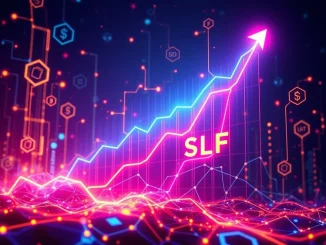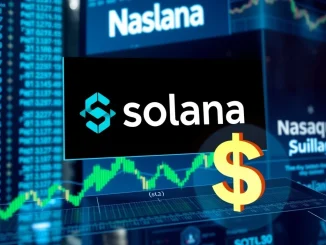
For crypto enthusiasts, the lines between traditional finance and decentralized innovation are blurring faster than ever. Imagine a world where institutional investments operate 24/7, powered by the very technology that underpins your favorite digital assets. That future is now arriving, as major players like Goldman Sachs and BNY Mellon make significant strides in integrating blockchain into their core offerings, marking a pivotal moment in Ethereum News and the broader digital asset landscape.
The Dawn of Tokenized Funds: Goldman Sachs and BNY Mellon Lead the Charge
In a move set to redefine institutional liquidity management, Goldman Sachs and BNY Mellon have announced the launch of tokenized money market funds. This initiative is specifically designed for institutional investors, leveraging advanced blockchain technology to enable unprecedented efficiency. The core aim is to enhance operational processes by dramatically reducing settlement times from days to minutes and allowing for fractional ownership of assets. This collaboration signifies a major step in digitizing traditional financial instruments.
Laide Majiyagbe, Global Head of Liquidity at BNY Mellon, highlighted the firms’ commitment to scalable and secure digital finance solutions. These tokenized funds operate on a private blockchain ledger, offering institutional clients continuous market access and improved transparency. By recording ownership on a distributed ledger, the system directly addresses long-standing inefficiencies in traditional fund settlement, which often involve delays and limited operational windows.
Blockchain Settlement: Unlocking 24/7 Efficiency for Institutions
The true power of this new offering lies in its innovative use of blockchain settlement. Traditional financial markets typically operate within restrictive hours, leading to settlement delays and liquidity bottlenecks. The tokenized funds, however, support 24/7 settlement and real-time ownership tracking. This means institutional investors can manage liquidity with greater precision, as the tokenization framework supports programmable asset management and trading on decentralized networks. This innovation aligns with a broader industry trend toward blockchain adoption, as firms modernize infrastructure to meet evolving regulatory and market demands.
Key benefits of this blockchain-powered approach include:
- 24/7 Accessibility: Funds can be traded and settled around the clock, eliminating traditional market hour constraints.
- Real-time Tracking: Ownership and transactions are recorded instantly on the distributed ledger, enhancing transparency.
- Reduced Settlement Times: Processes that once took days now complete in minutes, freeing up capital faster.
- Fractional Ownership: Enables more granular investment and management of assets.
- Enhanced Operational Efficiency: Streamlines back-office processes and reduces manual reconciliation.
Beyond Stablecoins: The Rise of Tokenized Money Market Funds
The regulatory environment has played a pivotal role in the development and increasing traction of these tokenized funds. The recent passage of the GENIUS Act, which prohibits interest-bearing stablecoins in the U.S., has created a landscape where alternative digital yield instruments, such as tokenized funds, are gaining significant attention. Unlike stablecoins, these funds generate returns by investing in government-backed securities and short-term instruments, maintaining low volatility.
Moody’s reported that tokenized short-term funds have already attracted $5.7 billion in assets since 2021, underscoring growing institutional interest. This regulatory clarity, combined with advancements in blockchain infrastructure, has positioned traditional financial institutions to lead in digital finance innovation.
Goldman Sachs’ Strategic Vision in Digital Assets
The timing of this announcement reflects a strategic alignment with broader market dynamics. The initiative follows Goldman Sachs’ earlier exploration of tokenization solutions for real-world assets, announced just days prior. Mathew McDermott, Goldman Sachs’ Head of Digital Assets, has consistently highlighted the importance of robust regulatory frameworks in enabling institutions to scale crypto-related offerings, emphasizing the delicate balance between innovation and compliance.
This move by Goldman Sachs mirrors similar efforts by competitors like JPMorgan’s Onyx division, which has also ventured into blockchain-based settlement systems. This competitive landscape is driven by the need to address liquidity constraints in traditional markets and to capitalize on the efficiency gains offered by distributed ledger technology.
Impact on the Broader Digital Asset Landscape and Ethereum News
From an analytical perspective, this initiative signals profound institutional confidence in blockchain’s capacity to streamline financial processes. By tokenizing money market funds, Goldman Sachs and BNY Mellon address key pain points for institutional investors, including the need for faster transactions and enhanced transparency. While the technology offers clear operational advantages, widespread acceptance will require regulators to endorse tokenized assets as legitimate alternatives to conventional instruments.
The recent surge in institutional interest in digital assets—exemplified by Ethereum ETFs, which have amassed $15.7 billion in assets under management since their July 2024 launch—further highlights the sector’s potential. This project diverges from speculative forecasts often cited in crypto news. Unlike predictions about the future dominance of stablecoins or the tokenization of real estate, this initiative represents a tangible product launched on a private ledger. Its impact will be measured by institutional adoption rates and the efficiency gains it delivers compared to traditional money market fund structures.
Goldman Sachs’ foray into tokenized funds underscores its position as a fintech innovator, leveraging its capital markets expertise to bridge traditional and digital finance. As blockchain technology continues to evolve, the firm’s ability to navigate regulatory landscapes while delivering scalable solutions will likely determine the long-term success of this initiative.
Frequently Asked Questions (FAQs)
Q1: What are tokenized money market funds?
Tokenized money market funds are digital representations of traditional money market fund shares. They utilize blockchain technology to record ownership and transactions, enabling faster settlement and greater transparency compared to conventional funds.
Q2: How do Goldman Sachs and BNY Mellon’s new funds benefit institutional investors?
These funds offer institutional investors benefits such as 24/7 settlement, real-time ownership tracking, reduced settlement times (from days to minutes), fractional ownership, and enhanced operational efficiency. This allows for more precise liquidity management.
Q3: How does this initiative relate to Ethereum News?
While the funds operate on a private blockchain, this development is significant for Ethereum News and the broader digital asset space. It demonstrates increasing institutional confidence in blockchain technology, mirroring the success of products like Ethereum ETFs, and validates the underlying principles of digital finance.
Q4: What role does regulation play in the adoption of tokenized funds?
Regulatory clarity is crucial. The GENIUS Act, which prohibits interest-bearing stablecoins, has created an environment where tokenized money market funds are gaining traction as regulated digital yield instruments. Ongoing regulatory support is vital for widespread acceptance and scaling of these innovations.
Q5: Are these tokenized funds similar to stablecoins?
No, they are distinct. Unlike stablecoins, which aim to maintain a fixed value (often pegged to fiat currency), tokenized money market funds generate returns by investing in short-term, low-volatility assets like government-backed securities. They are designed as yield-bearing alternatives in a regulated framework.
Q6: What is the long-term outlook for tokenized assets in traditional finance?
The launch by Goldman Sachs and BNY Mellon signals a strong trend towards integrating blockchain into core financial services. The long-term success of tokenized assets will depend on continued regulatory alignment, widespread institutional adoption, and the demonstrable efficiency gains they offer over traditional financial instruments.



